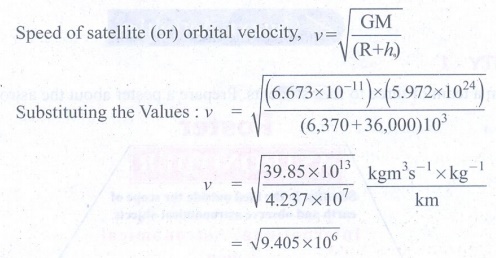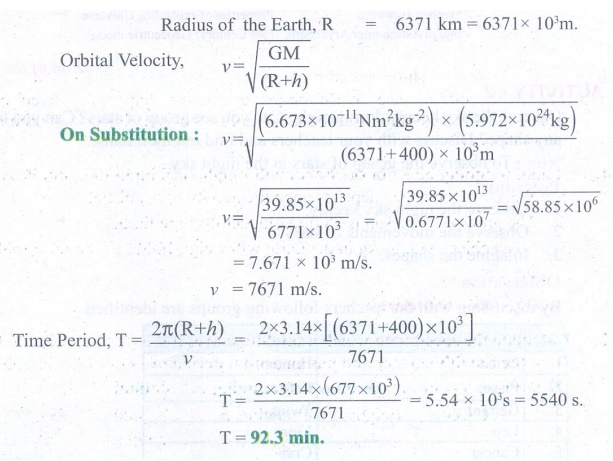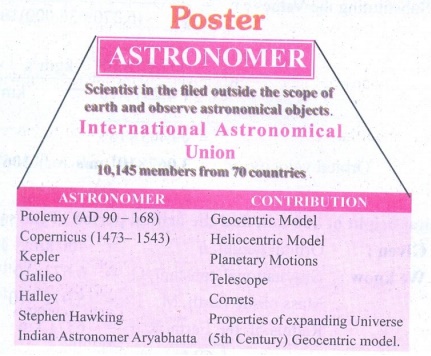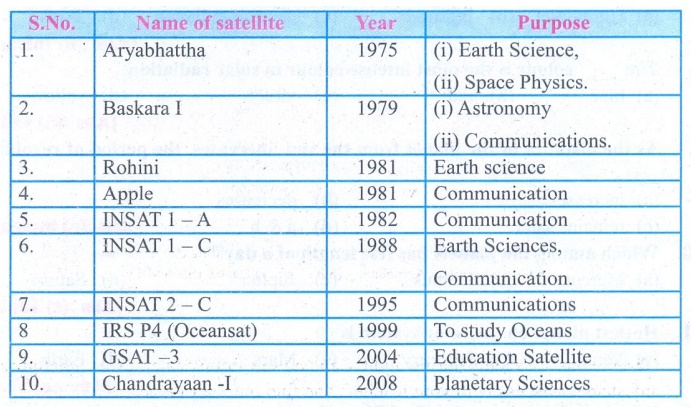Universe | Physics | Science - Answer the following questions | 9th Science : Physics : Universe
Chapter: 9th Science : Physics : Universe
Answer the following questions
UNIVERSE
TEXT BOOK EXERCISES
IV. Answer briefly:
1. What is solar system?
Answer:
1.
The Sun and celestial bodies which revolve around it form the solar system.
2.
It consists of larger number of bodies such as planets, comets, asteroids and meteors.
2. Define orbital velocity.
Answer:
The
horizontal velocity that has to be imparted to a satellite at the determined
height so that it makes a circular orbit around the planet is called ’’orbital
velocity”.
3. Define time period of a
satellite.
Answer: Time
taken by the satellite to complete one revolution round the Earth is called
time period of a satellite.
Time
Period, T = ( Distance covered / Orbital velocity )
4. What is a satellite? What are
the two types of satellites?
Answer: A body
moving in an orbit around a planet is called satellite.
The two types of
Satellites are
1.
Natural satellites,
2.
Man made satellites.
5. Write a note on the inner
planets.
Answer:
1.
The planet that are relatively close together and close to the sun. They form
the inner solar system and are called inner planets.
2.
There are four inner planets namely i. Mercury, ii.Venus, iii.Earth and iv.Mars.
3.
They have a surface of solid rock crust and are called terrestrial (or) rocky
planets.
6. Write about comets.
Answer:
1.Comets
are lumps of dust and ice that revolve around the Sun in highly elliptical
orbits.
2.
Their period of revolution is very long.
3.
Comet vapourises and forms a head and tail on approaching the sun.
4.
Tail of the biggest comet may be around 160 million km.
5.
There are period comets (e.g) Halley's comet which appears after every 76
years.
7. State Kepler’s laws.
Answer:
Kepler's, first law
-the law of ellipses
The
path of the planets about the Sun is elliptical in shape, with the centre of
Sun being located at one of the foci.
Second law-the law
of equal areas
An
imaginary line drawn from the centre of the Sun to the centre of the Planet
will sweep out equal areas in equal intervals of time.
Third law - the law
of Harmonics
The
ratio of the squares of the periods of any two planets is equal to the ratio of
the cubes of their semi major axis from the Sun.
8. What factors have made life on
Earth possible?
Answer:
Factors responsible
for life on Earth
1.
Right distance from the Sun.
2.
Right temperature.
3.
Presence of water.
4.
Suitable atmosphere.
5.
Blanket of ozone.
V. Answer in detail:
I. Give an account of all the
planets in the solar system.
Answer:
1. Mercury:
1.
It is a Rocky planet nearest to the Sun.
2.
It moves around the Sun faster than any other planet.
3.
It rotates very slowly.
2. Venus:
1.
It is almost the same size as the Earth.
2.
It is the Hottest planet in our solar system.
3.
It is brightest heavenly body in our night sky.
4.
It spins in the opposite direction to all other planets.
3. The Earth:
1.
The only Life-Supporting planet in the solar system.
2.
It appears Bluish green due to the reflection of light from water and land mass
on its surface.
3.
It moves around the Sun in 365.25 days and rotation period is 23.93 hours.
4. Mars:
1.
The first planet outside the orbit of the Earth.
2.
It is also called the Red Planet having two small natural satellites.
5. Jupiter:
1.
Jupiter is called as Giant planet.
2.
It is the largest of all planets.
3.
It has 3 rings and 65 moons.
4.
Its moon Ganymede is the largest moon of our solar system.
6. Saturn:
1.
It has bright shiny rings and appears yellowish in colour.
2.
It is the second biggest and a giant gas planet in the outer solar system.
7. Uranus:
1.
It is a cold gas giant and can be seen only with the help of large telescope.
2.
It has longest summers and winters.
8. Neptune:
1.
It appears as Greenish star and is the windiest plant.
2.
It has the largest moon - Triton that moves in opposite direction to the
direction in which its planet spins.
2. Discuss the benefits of ISS.
Answer:
1. Water
purification efforts:
The
water recovery system (WRS) and the oxygen generation system (OGS) techniques
developed by ISS provides advanced water filtration and purification to water
scarcity areas.
2. Eye tracking
technology:
Eye
tracking technology can be used in many laser surgeries which tracks eye's position
very accurately and helps the disabled people with limited movement and speech.
,
3. Robotic arms and
Surgeries:
Robotic
arms provide significant help to surgeons in removing inoperable tumor and
taking biopsies with great accuracies.
4.
Apart from the above, there are many other applications such as development of
improved vaccines, breast cancer detection and treatment and so on.
3. Write a note on orbital
velocity.
Answer:
Definition of
orbital velocity:
The
horizontal velocity that has to be imparted to a satellite at the determined
height so that it makes a circular orbit around the planet .
1.
The orbital velocity of the satellite depends on its altitude above the Earth.
2.
Nearer the object to the earth, faster is the required orbital velocity.
3.
At an altitude of 200 km, the required orbital velocity is little more than
27,400 kph.
Geostationary
orbit:
Satellite
stays in a fixed position all the time while earth rotates. This kind of orbit
is called geostationary.
Orbital velocity
formula: v = √ [
GM
/ (R+h) ]
G
- Gravitational constant (6.673 × 10-11 Nm2kg-2)
M
- Mass of the Earth (5.972 × 1024 kg)
R
- Radius of the Earth (6371 km).
h - Height
of the satellite from the surface of the Earth.
VI. Conceptual
questions:
1. Why do some stars appear blue
and some red?
Answer:
1.
Stars appear in different colours depending on their temperatures.
2.
Hot stars are white or blue in colour.
3.
Cooler stars are orange or red in colour.
2. How is a satellite maintained
in nearly circular orbit?
Answer:
1.
The satellite is carried by a rocket to the desired height and released
horizontally with a high velocity.
2.
So that it remains moving in a nearly circular orbit.
3. Why are some satellites called
geostationary?
Answer: The
Earth rotates once in 24 hours, a satellite stays in a fixed position. Because
the satellite stays over the same spot all the time, this kind of orbit is
called "geostationary".
4. A man weighing 60 kg in the
Earth will weigh 1680 kg in the Sun. Why?
Answer:
1.
Weight of the object depends upon the gravity of the planet.
2.
The gravity of the sun is 28 times higher than the Earth.
3.
So an object with 60 kg in the Earth will weigh 1680 kg (28x 60 = 1680 kg) in
the Sun.
VII. Numerical
problems:
1. Calculate the speed with which
a satellite moves if it is at a height of 36,000 km from the Earth’s surface
and has an orbital period of 24 hr (Take R = 6370 km).
[Solution: Convert
hr into seconds before doing calculation]
Solution:
Given: Height
of the satellite, h = 36,000 km =
(36,000) × 103m
Radius
of the Earth, R = 6370 km = (6370) ×
103m
We know:
Gravitational constant, G = 6.673 × 10-11 Nm2 kg-2
Mass
of the Earth, M = 5.972 × 1024 kg.

Orbital
velocity, v = 3.067 × 103 m/s
(or) 3067m/s (or) 3.067 km/s.
2. At an orbital height of 400
km, find the orbital period of the satellite.
Solution:
Given: Orbital
height, h = 400 km = 400 × 103m
We know: Gravitational
constant, G = 6.673 × 10-11Nm2kg-2
Mass of the Earth, M = 5.972 × 1024
kg

T = 92.3 min
Intext Activities
ACTIVITY - 1
Form a team of three to four
students. Prepare a poster about the astronomers.

ACTIVITY - 2
Observe the sky keenly during
night. Can you see group of stars? Can you figure out any shape? Discuss with
your teachers and find out their name.
Aim: To
observe the group of stars in the night sky.
Procedure:
1.
Observe the night sky keenly.
2.
Observe the movements of stars
3.
Imagine the shapes
Observation:
By
discussing with the teachers following groups are identified.

ACTIVITY -3
Watch the sky in the early
morning. Do you see any planet? What is its name? Find out with the help of
your teachers.
Aim:
1.
Most of the planets cannot be seen in normal sky.
2.
Few planets can be seen during some specific period in the night sky.
3.
Mercury,
closest to the sun can be seen from the earth.
4.
Venus
is also seen few days in a year.
5.
Uranus
may be also seen on odd days in October.
ACTIVITY -4
Prepare a list of Indian
satellites from Aryabhatta to the latest along with their purposes.

Related Topics